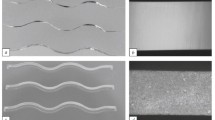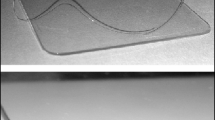The work performed on laser cutting of glass articles at the Scientific-Research Institute of Technical Glass is described.
Similar content being viewed by others
Avoid common mistakes on your manuscript.
The development of a technology for the manufacture of articles for structural optics is one of the main directions of work at the Scientific-Research Institute of Technical Glass (NITS JSC). Materials science and physical-chemical studies have made it possible to develop a host of new technological processes, including hardening of glass, shaping complex surfaces of high optical quality, deposition of transparent, electrically conducting, anti-reflection, heat-reflecting, radioprotective, light-dividing coatings, and gluing transparent high-strength compositions. The articles obtained by this technology surpass the foreign analogs by 20 – 30% in terms of strength, optical, and weight indices.
The need to develop methods for machining highstrength inorganic materials and compositions based on them is determined by the fact that at present, in order to machine glass, ceramic, and other composite materials the quality of the articles must be increased significantly while reducing the machining time.
One application of laser technologies is high-precision separation of miniature articles, for example, chips based on sapphire substrates, and large-size high-strength articles of structural optics, specifically, for aviation and space vehicles. A high-priority problem in the manufacture of large-size 3D articles is the development of a method of automated laser cutting. The laser method of cutting is distinguished by the fact that it does not require subsequent machining and it is more precise and of higher quality. In addition, it is more efficient compared with the laborious mechanical method.
The method of controlled laser thermal splitting is of greatest interest for dividing glass articles [1–8]. It is well known that the process of laser thermal splitting proceeds as follows. A microdefect, having the character of a mechanical microcrack, is created (or used). Next, this zone is heated locally by laser radiation. The rise in temperature results in the appearance of tensile stresses, which, concentrating on the microdefect, cause the defect to grow into a continuous through microcrack. The tensile stresses increase as a result of a cooling agent being introduced near the irradiation zone. The surrounding temperature gradients result in the appearance of nonuniform deformations, which in elastic materials inevitably engender compression and tensile stresses. The maximum tensile stress can occur at different points with respect to the trajectory of motion of the focal point of the radiation and the position of the center of the irradiation spot depending on the characteristics of the cooling zone.
The main factors determining the efficiency of the laser-controlled thermal splitting process are the characteristics of the laser radiator, the amount of coolant supplied and the conditions under which it is introduced into the heated zone as well as the thermophysical and mechanical properties, thickness, and surface state of the material being split.
Large-size glass articles with a complex 3D shape and planar articles are the main objects of controlled technological operations. The most important problem is to develop methods, equipment, and regimes for cutting such articles and removing oxide coatings from the surface of the glass according to a prescribed program.
Several problems must be solved in order to develop a high-efficiency technology for machining the glass articles of structural optics:
-
new methods using a high-precision a robotic laser complex must be developed to eliminate manual operations in the technology of cutting out 3D glass articles;
-
a software package for supporting the movement of the laser spot along a prescribed trajectory in space at a prescribed velocity must be developed;
-
scientific-research work, including complex physical-chemical studies and theoretical calculations of three-dimensional temperature fields and thermoelastic stresses arising under the conditions of laser irradiation and an experimental check of theoretical recommendations, must be performed;
-
recommendations concerning the velocity characteristics, the cutting quality for glass of different thickness, and the required end-face profile of a glass article, eliminating subsequent machining, must be adopted;
-
a technology for removing a metalized coating from the surface of the glass must be developed.
A pilot stand was developed to work out a technology for cutting and machining the edges and surfaces of large-size silicate glass with double curvature in an automated regime. This stand makes it possible to develop recommendations on switching to a qualitatively higher level of technology and to automate the cutting of glass blanks and, in consequence, increase productivity and reduce manufacturing time for glass articles.
The structural layout of a robotic laser stand for cutting glass consists of a mechanical manipulator based on a high-precision robot with software and a set of laser tools with software. The block diagram (Fig. 1) includes the following: a robotic manipulator 1; fiber-optical ytterbium laser 2; chiller (laser cooler) 3; fiber-optic cable 4; output section of the robot (head) 5; collimating setup for the laser 6; focusing setup of the laser—optical head 7; coolant feeder 8; setup for fixing the object being machined 9; and, controller 10. The external appearance of the stand is displayed in Fig. 2.
The laser cutting of 3D articles gives at the same time articles with blunted end faces which do not require subsequent machining. The blunted end faces of glass articles obtained by laser cutting are shown in Fig. 3.
It should be noted that articles obtained by the laser method are stronger than those obtained by other methods [9, 10].
The results of strength tests of plates cut out by different methods are shown in Fig. 4.
Strength σ i in transverse three-point bending of glass blanks for different types of cutting — laser and mechanical: I) thermally polished sheet glass; II) quartz glass; III) sheet glass, laser cutting; IV) sheet glass; cutting with a glass cutter [a, b, c) minimum, maximum, and average values, respectively] [10].
The method of laser machining of large-size 3D glass articles and a setup for implementing it are protected by patents [11, 12].
In summary, the laser technology developed at NITS JSC for cutting articles from silicate glass significantly increases the quality of complicated structural elements of aircraft, providing a new, higher level of the articles that meets the modern, higher requirements of modern industry.
References
G. A. Machulka, Laser Machining of Glass [in Russian], Radio i Svyaz’, Moscow (1979).
V. S. Kondratenko, Laser Controlled Thermal Splitting of Brittle Materials [in Russian], MGUPI, Moscow (2007).
E. M. Belousov, V. S. Kondratenko, G. A. Machulka, and V. V. Chuiko, “Controlled thermal splitting of glass by 10.6 μm laser radiation,” Élektronnaya Prom-st’, No. 9, 40 – 45 (1979).
V. S. Kondratenko, Method for Cutting Nonmetallic Materials, RF Patent No. 2024441 [in Russian] (1994).
A. B. Zhimalov, V. F. Solinov, V. S. Kondratenko, and T. V. Kaplina, “Laser cutting of the float glass upon production,” Steklo Keram., No. 10, 3 – 5 (2006); A. B. Zhimalov, V. F. Solinov, V. S. Kondratenko, and T. V. Kaplina, “Laser cutting of the float glass upon production,” Glass Ceram., 10(10), 3 – 5 (2006).
V. F. Solinov, V. S. Chadin, and T. A. Aliev, “Structural materials, equipment, and technology,” Modeli Lazer. Rezki Stekla, No. 5, 10 – 14 (2004).
V. F. Solinov, V. S. Chadin, T. A. Aliev, et al., Method of Laser Cutting of Brittle Transparent Nonmetallic Materials, Eurasian Patent No. 012311 [in Russian] (2009).
O. V. Trubienko, Investigation and Development of a Technology for Blunting the Sharp Edges of Articles by Means of Laser Controlled Thermal Splitting, Author’s Abstract of Candidate’s Thesis [in Russian], Moscow (2009).
V. A. Brest and V. I. Shelyubskii, “Strength of glass under a prolonged load,” Steklo Keram., No. 6, 14 – 16 (1971); V. A. Brest and V. I. Shelyubskii, “Strength of glass under a prolonged load,” Glass Ceram., 48(6), 247 – 250 (1971).
M. E. Kustov, I. S. Kurchatov, E. N. Muravyev, et al., “The impact of various processing methods on strength behaviour of silicate glasses,” Steklo Keram., No. 5, 22 – 24 (2013); M. E. Kustov, I. S. Kurchatov, E. N. Muravyev, et al., “The impact of various processing methods on strength behaviour of silicate glasses,” Glass Ceram., 70(5 – 6), 183 – 185 (2013).
V. F. Solinov, E. F. Solinov, É. N. Murav’ev, et al., Method of Laser Machining of Brittle Materials and a Setup for Implementing It, RU Patent 201219734 [in Russian], May 15, 2012.
É. N. Murav’ev, V. I. Revenko, V. F. Solinov, et al., Technological Objects for Laser Machining, RU Patent 2504809 [in Russian], March 26, 2012.
Author information
Authors and Affiliations
Corresponding author
Additional information
Translated from Steklo i Keramika, No. 9, pp. 6 – 8, September, 2014.
Rights and permissions
About this article
Cite this article
Solinov, E.F., Solinov, V.F., Buchanov, V.V. et al. Application of Laser Technology for Cutting Glass Articles. Glass Ceram 71, 306–308 (2015). https://doi.org/10.1007/s10717-015-9675-9
Published:
Issue Date:
DOI: https://doi.org/10.1007/s10717-015-9675-9








